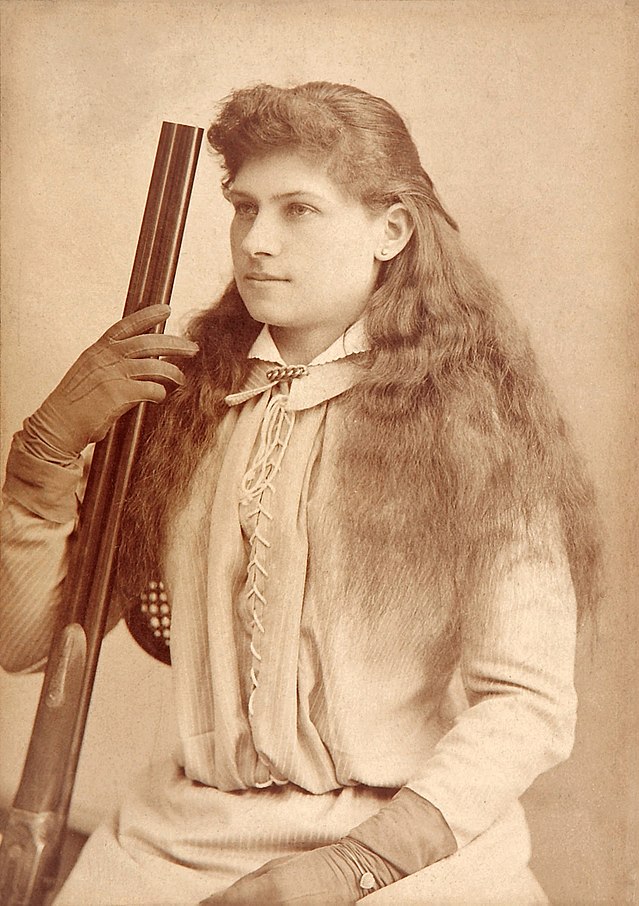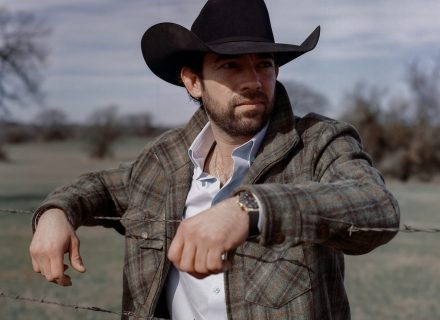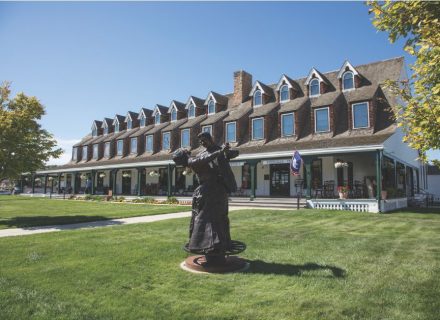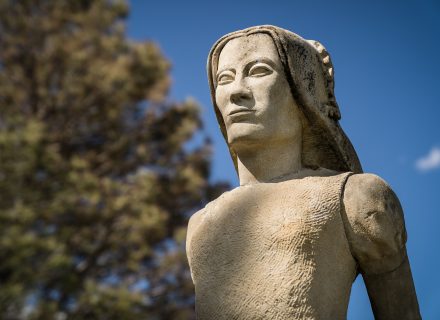When Annie got her gun, the whole world took notice.
A bull’s-eye on the shooting and exhibition circuit in her day, Annie Oakley became a legend in her own lifetime. Almost 100 years after her death, she remains legendary and is the namesake of many trap-shooting tournaments.
According to the Trapshooting Hall of Fame, where she was inducted in 1969, Oakley — born Annie Moses on August 13, 1860 — learned to shoot at the age of 8 with her father’s old 40-inch cap and ball Kentucky rifle.
“In the fall of 1875, when she was 15, she was invited to take part in a shooting match in Cincinnati against Frank Butler, a champion marksman. Butler thought it was a joke, but he was more than convinced that it was no farce when young Annie beat him fair and square. A year later Miss Moses became, in private life, Mrs. Frank Butler. When Annie joined Frank’s shooting act, she became Annie Oakley,” according to her bio for the Trapshooting Hall of Fame.
“The Butlers — Annie and Frank — joined the Four-Paw and Sells Brothers Circus in 1880 as a shooting act. They met the great Sioux Indian chief Sitting Bull in St. Paul, Minnesota, in 1882, at which time Annie was adopted into the tribe as ‘Mochin Chilla Wytonys Cecilia,’ which is the Sioux Indian name for ‘My Daughter, Little Sure Shot.’ Two years later the Butlers joined the Wild West Show and traveled with Buffalo Bill Cody’s group for 17 years. Annie broke her first 100 straight at trap in a match race in London in 1887, setting a club record.
“Annie Oakley is personally credited with saving the Wild West show during its 17-month tour of Europe. During that time Annie was giving two performances a day, seven days a week. When it seemed the show was doomed because of financial failure, Annie took $8,000 of her savings to rescue it,” according to the Trapshooting Hall of Fame & Museum.
Not only could she shoot, she could influence. “Annie was liberating for a great many women. She was a wildly successful entertainer. And she was really on the order of an Olympic athlete,” says [historian and Oakley expert] Dr. Paul Fees on Ohio History Connection. “She was only 5 feet tall but was incredibly strong. She had to be strong. Her rifle was 6 pounds, and she’d shoot it at targets hundreds of times a day, thousands of times during the run of a [Wild West] show, all the while running and riding her horse and doing handsprings.”
After touring for years as a main attraction with Buffalo Bill’s Wild West, she taught the art of marksmanship to thousands of women and girls, many of whom surely went on to teach their own daughters and granddaughters. While she and her husband, Frank, had no children of their own, Oakley’s wish was for women to know how to handle a gun as naturally as they handled a baby.
“I have been teaching women to shoot for many years at [the New Hampshire] Wentworth [Hotel] in summer and [North Carolina’s Carolina Hotel in] Pinehurst in winter, without compensation because I had an ideal for my sex. I have wanted them to be capable of protecting their homes,” she once said.
She considered shooting not just key to self-defense but also key to longevity: “If there is any sport or recreation more conducive to good health and long life than shooting, I do not know what it is,” she said. “Why spend the afternoon at the bridge table, sipping tea, when there always is a gun club near where you may shoot at the targets.”
According to The Life and Legacy of Annie Oakley by Glenda Riley, Oakley favored good-quality guns — usually preferring plain guns with good wood in the stocks and open sights. She believed that “the shooter’s physique, type of game, and fancy should govern his or her choice of gun” and that “the best gun is the gun that best fits the shooter.”
“Nobody should trust their lives behind a cheap gun,” Oakley once said in a magazine interview. The makers she trusted for her own shooting, according to the book Annie Oakley by Shirl Kasper, were, for short guns, Lancaster, Cashmore, Francotte, Parker, Purday, Spencer, Scott, L.C. Smith, Ithaca, Cranston, and P. Webley & Sons. Her rifles included Winchester, Stevens, Marlin, Lancaster Hooland, and Remington. Her pistols and revolvers were Smith & Wesson, Stevens, Colt, and Renette.
Oakley’s Trapshooting Hall of Fame entry relates that her shooting prowess made her a celebrity during her lifetime, and she performed many times in front of royalty in Europe. “She particularly treasured a silver trophy awarded to her by then Prince of Wales Edward VII, which he had specially inscribed ‘You are the best shot I have ever seen.’ An idea of her value may be better understood when it is realized that she commanded and received $700 a week during the tour of Europe. She also won $9,000 in two years of trapshooting, during a time when money was hard to come by and her appearances at tournaments were limited.”
Her pet trick was one she liked to do at Pinehurst: “She would lie on her back and have her husband throw six glass balls in the air at once. She would empty the entire contents of three double-barrel shotguns, breaking all six targets before they reached the ground.”
After a train accident in 1921 left her in a brace for the rest of her life, she returned to Pinehurst the following year and broke 100 clay targets. “In the years following World War I, Annie and Frank lived in Pinehurst and worked for the old Carolina Hotel. Frank ran a gun club there and Annie gave shooting lessons and exhibitions. Annie appeared at the 1925 Grand American in Vandalia, Ohio. Although she was in poor health, and it was just a year before her death, she was talked into shooting and she broke 97 out of 100 targets!” says Terry Waldron, director of the Trapshooting Hall of Fame & Museum.
During her three decades of shooting, Annie Oakley “fired well over a million shells” and “won more than $100,000 and numerous trophies.”
She died on November 3, 1926, in Greenville, Ohio, at age 66. Her husband, Frank, died three weeks later. They were buried on Thanksgiving Day and lie at rest together in her family plot in Brock Cemetery in Darke County, Ohio.
Read “Seven Ways to Take in Annie Oakley” and our feature on the famous Wild West markswoman from the October 2024 issue.




















